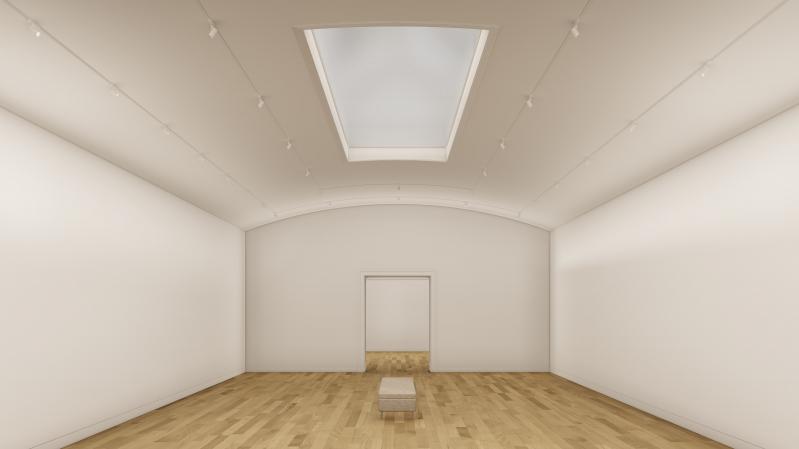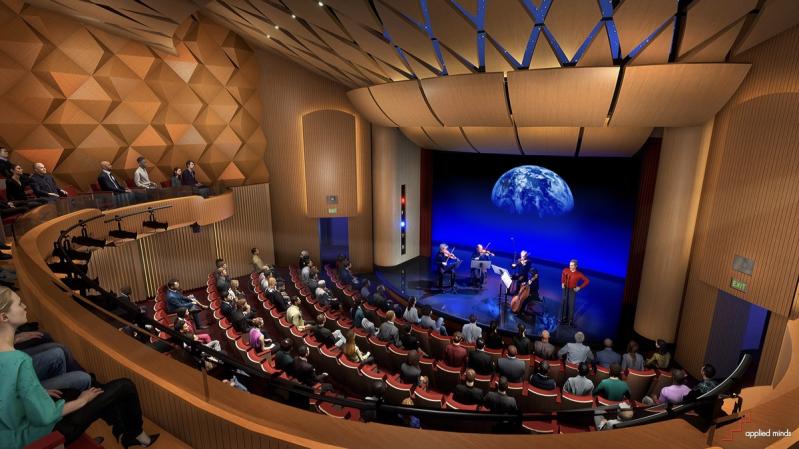No one would call the current Guild Hall complex a caterpillar, but after the dormancy of its building due to construction that will continue until spring of 2023, it will emerge refreshed and technologically agile.
Revealing the plans last week for renovations of the theater, galleries, education center, offices, and grounds, Andrea Grover, its executive director, said they were a response to Guild Hall's history with major American visual, performing, and literary artists and the multidisciplinary way artists in these fields are showing their work today, as well as the way audiences encounter them.
While much, including the building's footprint, will remain the same, the experience of seeing art or watching a play, film, concert, or talk will be vastly improved, with better lighting, acoustics, sight lines, and comfort. This will be accomplished by a team that includes Peter Pennoyer, Bran Ferren, and Ed Hollander.
With an early goal of $10 million met in 2021, the institution has upped its capital campaign to $25 million to include the building project plus the advancement of its arts program and its reserve fund.
Ms. Grover said the consultants they hired in 2019 to come up with a five-year strategic plan identified the interdisciplinary aspect of the institution as "something that had yet-to-be-realized potential. So that led into the idea that we could make our building more adapted to the way that artists are working today and to the way that audiences in our society like to participate with the arts."
At the same time, they were aware that the building acts as a gateway to the village along with the library and other buildings first encountered after passing Town Pond.
This became one of the themes of their discussions with Mr. Pennoyer of Peter Pennoyer Architects, which specializes in renovating and preserving historic buildings, including the design of the clock in the new Moynihan Train Hall in New York City. Mr. Pennoyer said on Saturday he had been coming to East Hampton for most of his life, and that Guild Hall was important in the overall sense of place of the village.
"It's very tempting when you're hired to work on an institution that is so public to leave your own personal mark -- an addition or something that leaves your design stamp on it," he said. Instead, he saw this as an opportunity to undo some of the changes that had been made over the years and "take what was really special about the building when [Aymar] Embury designed it . . . and restore it beautifully."
The approach is to add by subtraction, such as removing things like the first set of entry doors and windows to open up the original archway and make the entrance appear more welcoming.

Guild Hall is also working with Mr. Hollander of Hollander Design Landscape Architects on restructuring and replanting the grounds, including the gardens and parking area. They plan to install a front patio with tables and chairs to make the outdoor space more appealing and comfortable to visitors after a gallery visit, before curtain, or during intermissions.
Inside, the most dramatic changes will take place in the theater. These are being overseen by Mr. Ferren, who is a co-founder of the technology and creative design firm Applied Minds, LLC, an East Hampton native, and a former Guild Hall technical director.
Ms. Grover recalled contacting him while doing research for the "Guild Hall for All" anniversary book. Through several conversations it became obvious that Mr. Ferren, whose father was an Abstract Expressionist artist and whose mother was a curator of the museum, loved the place and wanted to help.
Despite rumors to the contrary, "There's nothing happening to the fundamental architecture. Its footprint is not expanding," Ms. Grover noted. "What's happening is the surfaces of the theater are being treated to make them better acoustically." The stage will also be built farther out into the audience and the seating will be raised to place viewers closer to the performers' eye level.
The boxes and center aisle will be removed, increasing intimacy with the stage and allowing seating to be where the best views are. The rows, both in the orchestra and in the balcony, will wrap around the stage for better sight lines. Seats will also be larger, more comfortable, and offer greater leg room. Access to them from the side aisles will be much easier with the greater floor space between the rows. In addition, the theater will be more easily accessible for those with disabilities.
Preservationists have voiced concern about the octagonal circus tent ceiling being lost in the new design. It will continue to exist, but will be mostly covered by a shell of acoustic reflectors that will dramatically improve the quality and uniformity of sound in the theater.
"In fact, through the spaces in the shell you can see the ceiling above it," Mr. Ferren said, adding, "People are putting a little too much emphasis onto the ceiling."
"The ceiling is an element of it," he admitted. "But from my perspective, we're not designing around the ceiling any more than we're designing around the floor, any more than we're designing around the doors. All of these are things that we take into consideration when designing a space."
He said the current layout of the theater is not as intimate with the stage as it could be. For example, "When you're sitting in the boxes, you feel very disconnected from the stage and from other parts of the theater. So we're doing a lot to create a much more intimate experience . . . for the artists and the performers as well as the audience."
Also key to the performances in the new space will be state-of-the-art recording and broadcasting equipment, allowing a show to have a potential audience far beyond the 360 people in the venue -- potentially millions more. "It's a big world out there, with eight billion people," Mr. Ferren said, "with about seven and a half billion cellphones, of which 73 percent are smartphones."
In this environment, issues of capacity or how many people are willing to travel to see a show become inverted. "If an institution like Guild Hall gets it right, the online audience will always be vastly bigger than the physical audience. But that doesn't make it any less important."
Changes are afoot in other areas of the building as well. In the galleries, doorways and passthroughs will be moved to increase wall space, sight lines, and flow. The main doorways will be enlarged to allow monumentally sized works to fit through them. Their current size has been a barrier to including some major works of modern and contemporary art in exhibitions there.

One of the dramatic changes will be the removal of the current dropped flat ceiling to reveal its original vaulted design. The vaults have inset laylights, interior rectangular windows that can let in natural light or be screened to protect delicate works. Mr. Pennoyer said the windows can also be inlaid with LED lighting for evening or nighttime use. The lighting will change to LED in the galleries and throughout the facility, which will save significant amounts of energy.
The education center will be updated with the latest technology for workshops and classes. The Teen Arts Council also uses the space as part of its yearlong mentorship and apprenticeship program.
The offices in the basement will be redesigned as well to maximize natural light and incorporate a more contemporary layout, reflective of current office design and postpandemic seating requirements.
Ray Harden, a co-owner of Ben Krupinski Builder, will lead the construction team. Sag Harbor's Chris DiSunno of DiSunno Architecture will coordinate the theater improvements.
Reflecting on how the community might respond to the new setting, Mr. Ferren summed it up in relation to the theater. "Are there people that are going to miss the chandelier or the wall sconces, or a ram's head or something? You know, I'm sure there will be. But at a certain point you say, well, there's a little more to a theater than decorative ornamentation."
"We're not approaching it from the perspective of 'I have to get rid of all of this old stuff.' It's exactly the opposite," he said. The focus is on reconceptualizing the space for two groups: kids -- "the audiences of the future and how we get them to love the arts" -- and artists -- establishing "new connections between them, their art, and the audience."
"I'm worried about the next 90 years. And at the same time, I'm completely respectful of the last." He said he couldn't think of anyone, even if by accident, who is "more connected with that theater, its history and its place. But from my perspective, the job I've been given is to invent the best possible set of circumstances for the future to enable creativity, moving experiences, and theater presentations that touch people's hearts, open their eyes, and develop in them a lifelong passion for the arts. That to me is the priority."




